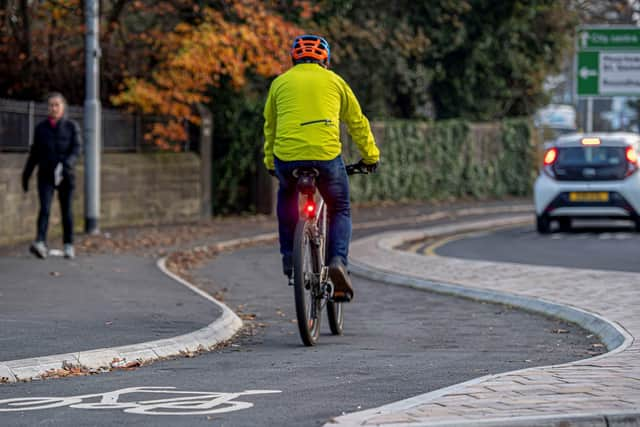Public consultation to be held as Leeds council lays out plans to ensure nobody is killed on city's roads
and live on Freeview channel 276
Leeds City Council is proposing a fundamental change in its approach to tackling road danger.
A public consultation started yesterday (Monday, February 28) for people who visit, live and work in Leeds to shape the proposals.


Advertisement
Hide AdAdvertisement
Hide AdThe draft Leeds Safer Roads Vision Zero 2040 strategy sets out an ambitious plan to transform road safety.
Vision Zero is a ground-breaking approach to reducing road danger, based on the ethical position that nobody should die or suffer serious injury when walking, cycling, riding, or driving on the roads.
The strategy, developed by the Leeds Safer Roads Partnership, is made up of five ‘Safe System pillars’ to comprehensively address road danger. These are:
Safe Behaviours and People - encouraging behaviours that help to keep all road-users safe, focusing on preventing speeding, seatbelt offences, drink and drug driving, and distraction.
Advertisement
Hide AdAdvertisement
Hide AdSafe Speeds - stopping people driving at illegal, dangerous and inappropriate speeds through street design, targeted enforcement, reviewing speed limits and education campaigns.
Safe Roads - designing streets that put the needs of people above those of vehicles. That means creating streets that are safer for active travel, such as walking and cycling, and reduce the likelihood and severity of collisions.
Safe Vehicles - raising awareness about responsibility for roadworthy vehicles, enforcing offences and considering how technology and design features can help to prevent crashes.
Post-collision Learning and Care - raising awareness of support services, improving understanding of road danger and advocating for justice for road-crash victims.
Advertisement
Hide AdAdvertisement
Hide AdThe Safe System model considers the broader context of road safety and advocates for systemic change. It requires everyone to play their part. While all road users will be encouraged to behave safely and legally, responsibility will also sit with those who plan and manage the transport system.
Councillor Helen Hayden, Leeds City Council executive member for infrastructure and climate said:
“This new strategy will transform our approach to road safety. We need to remember that behind every statistic a person is killed or seriously injured on our roads. Someone’s life has been cut short, leaving behind a devastated family, or their health has been adversely affected.
“Our vision is that by 2040 no one will be killed or suffer serious injuries on roads in Leeds. The strategy sets out our plan to achieve this and make the roads safer for people to walk and cycle. I am very proud that Leeds is the first city in West Yorkshire to adopt the ‘Vision Zero’ approach."
Advertisement
Hide AdAdvertisement
Hide AdCommitments in the new strategy include data-led enforcement, working with communities and partners, and promoting a culture of traffic safety. Existing initiatives such as Operation SPARC, Operation SNAP, speed compliance activities and targeted road safety training will be further developed.
The strategy reflects the Highway Code’s hierarchy of road users, which prioritises pedestrians and cyclists, and states that road users who can do the greatest harm to others have a greater responsibility to behave safely.
Significant progress has been made in reducing casualties on Leeds’s roads since 2000, but in recent years the decline has levelled off.
Between 2016 and 2020, crashes on roads in Leeds killed 83 people and seriously injured 1,498 people. A further 8,317 people suffered minor injuries, bringing the total number of injuries and deaths to 9,898. Road crashes usually involve motor vehicles, but most of the victims who were killed or seriously injured were walking, cycling, or riding a motorbike.
Advertisement
Hide AdAdvertisement
Hide AdChief Superintendent Ed Chesters, West Yorkshire Police said:
“Despite significant improvement over recent years, people are still dying or suffering serious injury on roads in Leeds. That’s why safer roads are a Policing and Crime Plan priority, and we are committed to working with Leeds City Council to reduce road danger.
“We welcome the adoption of the Vision Zero strategy in Leeds, which represents a real opportunity to bring about significant changes to the way that we work together to make the roads safer for everyone. The strategy will help us to cut the risk of collisions, increase community confidence and promote safer, more active and sustainable travel."
Two public consultation events are taking place for people to ask questions and learn more:
Advertisement
Hide AdAdvertisement
Hide AdDrop-in event: Tuesday, March 22, 12pm - 5pm at Leeds Kirkgate Market, Vicar Lane, LS2 7HY.
Online webinar: Friday, March 25, 12pm - 1pm.
Support the YEP and become a subscriber today. Enjoy unlimited access to local news and the latest on Leeds United. With a digital subscription, you see fewer ads, enjoy faster load times, and get access to exclusive newsletters and content. Click here to subscribe.
